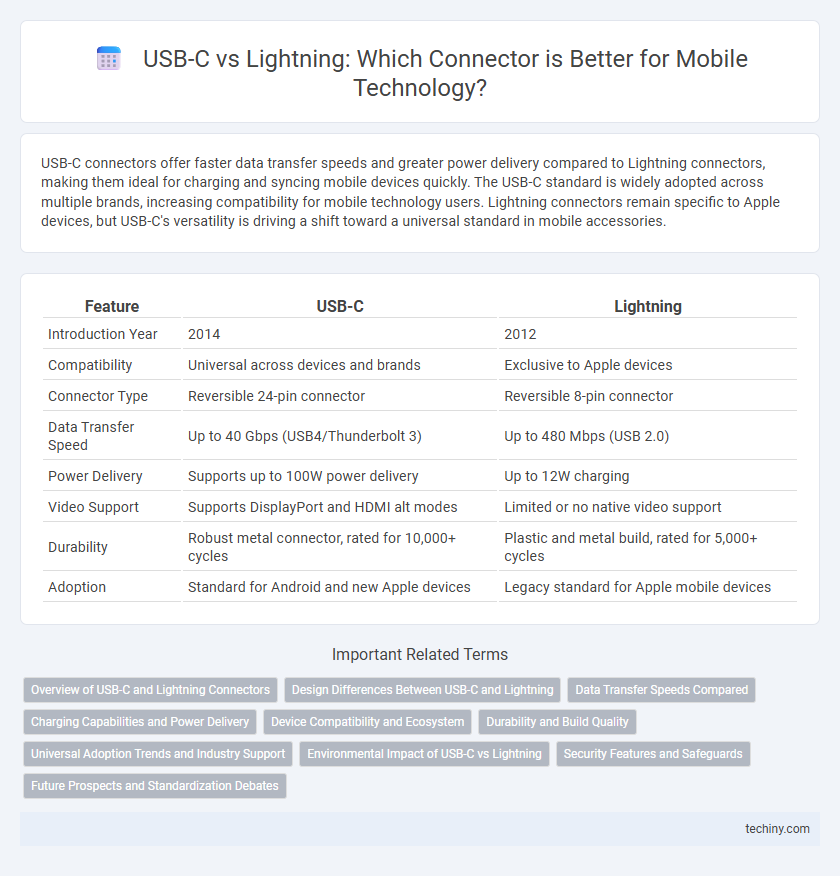USB-C connectors offer faster data transfer speeds and greater power delivery compared to Lightning connectors, making them ideal for charging and syncing mobile devices quickly. The USB-C standard is widely adopted across multiple brands, increasing compatibility for mobile technology users. Lightning connectors remain specific to Apple devices, but USB-C's versatility is driving a shift toward a universal standard in mobile accessories.
Table of Comparison
| Feature | USB-C | Lightning |
|---|---|---|
| Introduction Year | 2014 | 2012 |
| Compatibility | Universal across devices and brands | Exclusive to Apple devices |
| Connector Type | Reversible 24-pin connector | Reversible 8-pin connector |
| Data Transfer Speed | Up to 40 Gbps (USB4/Thunderbolt 3) | Up to 480 Mbps (USB 2.0) |
| Power Delivery | Supports up to 100W power delivery | Up to 12W charging |
| Video Support | Supports DisplayPort and HDMI alt modes | Limited or no native video support |
| Durability | Robust metal connector, rated for 10,000+ cycles | Plastic and metal build, rated for 5,000+ cycles |
| Adoption | Standard for Android and new Apple devices | Legacy standard for Apple mobile devices |
Overview of USB-C and Lightning Connectors
USB-C and Lightning connectors serve as vital interfaces in mobile technology, with USB-C emerging as a universal standard supporting fast data transfer rates up to 40 Gbps and power delivery up to 100W. Lightning connectors, proprietary to Apple devices since 2012, offer a compact 8-pin design optimized for iOS hardware with data transfer speeds typically around USB 2.0 standards. Both connectors facilitate charging, audio, and video output, but USB-C's widespread adoption across brands enhances compatibility and future-proofing compared to Lightning's ecosystem-limited use.
Design Differences Between USB-C and Lightning
USB-C features a reversible, symmetrical oval shape measuring 8.4mm by 2.6mm, supporting faster data transfer and higher power delivery compared to Lightning's thinner 6.7mm by 1.5mm design with an 8-pin configuration. USB-C's standardized size accommodates a wide range of devices and peripherals, enhancing universal compatibility, whereas Lightning is proprietary to Apple devices, limiting cross-platform use. The robust metal shell of USB-C connectors provides greater durability and resistance to wear, contrasting with the smaller, plastic-encased Lightning connectors.
Data Transfer Speeds Compared
USB-C connectors support data transfer speeds up to 40 Gbps with Thunderbolt 3 and 4 protocols, significantly faster than the Lightning connector's maximum rate of 480 Mbps with USB 2.0 standards. The USB-C interface enables rapid file transfers and high-resolution video output, making it superior for data-intensive mobile applications. In contrast, Lightning's limited transfer speed restricts performance, especially for professional users requiring quick backup and media transfers.
Charging Capabilities and Power Delivery
USB-C supports higher charging speeds with power delivery up to 100W, enabling fast charging for a wide range of devices including smartphones, tablets, and laptops. Lightning connectors, limited to about 18W charging power, provide slower charge rates mainly optimized for Apple devices. The USB-C standard offers broader compatibility and faster power transfer, making it the preferred choice for efficient mobile technology charging.
Device Compatibility and Ecosystem
USB-C connectors offer broad device compatibility across various smartphones, tablets, laptops, and peripherals, fostering a unified ecosystem for charging and data transfer. Lightning connectors remain exclusive to Apple devices, ensuring seamless integration within the Apple ecosystem but limiting cross-brand interoperability. The widespread adoption of USB-C promotes enhanced convenience and reduces the need for multiple cables, while Lightning maintains optimized performance within its proprietary environment.
Durability and Build Quality
USB-C connectors feature a more robust and reversible design with reinforced metal casings, providing higher durability and resistance to frequent plugging cycles compared to Lightning connectors, which have a smaller, thinner build more prone to wear and bending. USB-C's standardized construction supports faster data transfer and power delivery without compromising structural integrity, whereas Lightning connectors can experience pin damage over time due to their exposed contacts. The superior build quality of USB-C enhances overall longevity, making it the preferred choice for heavy mobile device users seeking durability and resilience in charging ports.
Universal Adoption Trends and Industry Support
USB-C connectors have gained widespread universal adoption across major smartphone manufacturers, including Android device makers, due to their faster charging speeds, higher data transfer rates, and compatibility with multiple device types. In contrast, Apple's Lightning connector remains proprietary, limiting its use primarily to iPhones and select accessories despite growing pressure from regulatory bodies to adopt USB-C for standardization. Industry support heavily favors USB-C as the global standard, promoting interoperability, reducing electronic waste, and simplifying consumer experience across mobile technology ecosystems.
Environmental Impact of USB-C vs Lightning
The USB-C connector reduces electronic waste through its universal compatibility across multiple devices, eliminating the need for proprietary cables like the Lightning connector used exclusively by Apple. USB-C cables support faster data transfer and charging standards, extending device lifespan and reducing frequent replacements. Widespread adoption of USB-C promotes sustainable manufacturing practices and minimizes resource consumption compared to the proprietary Lightning ecosystem.
Security Features and Safeguards
USB-C connectors incorporate advanced security protocols, such as USB Power Delivery authentication and data encryption, reducing risks of unauthorized access and power-related damage. Lightning connectors rely on Apple's proprietary authentication chip, offering a secure connection that prevents counterfeit accessories but limits cross-device compatibility. Both standards implement safeguards to protect against data breaches and electrical faults, with USB-C emphasizing universal security measures and Lightning focusing on ecosystem control.
Future Prospects and Standardization Debates
USB-C is rapidly becoming the universal charging and data transfer standard across mobile devices due to its superior data speeds, power delivery, and compatibility with various electronics. Apple's continued use of the Lightning connector sparks debates over ecosystem lock-in versus industry-wide standardization driven by regulatory bodies like the EU mandating USB-C adoption for environmental and consumer convenience reasons. Future prospects heavily favor USB-C as manufacturers aim to reduce electronic waste and enhance interoperability, signaling a gradual phase-out of proprietary connectors like Lightning.
USB-C vs Lightning connector Infographic

 techiny.com
techiny.com